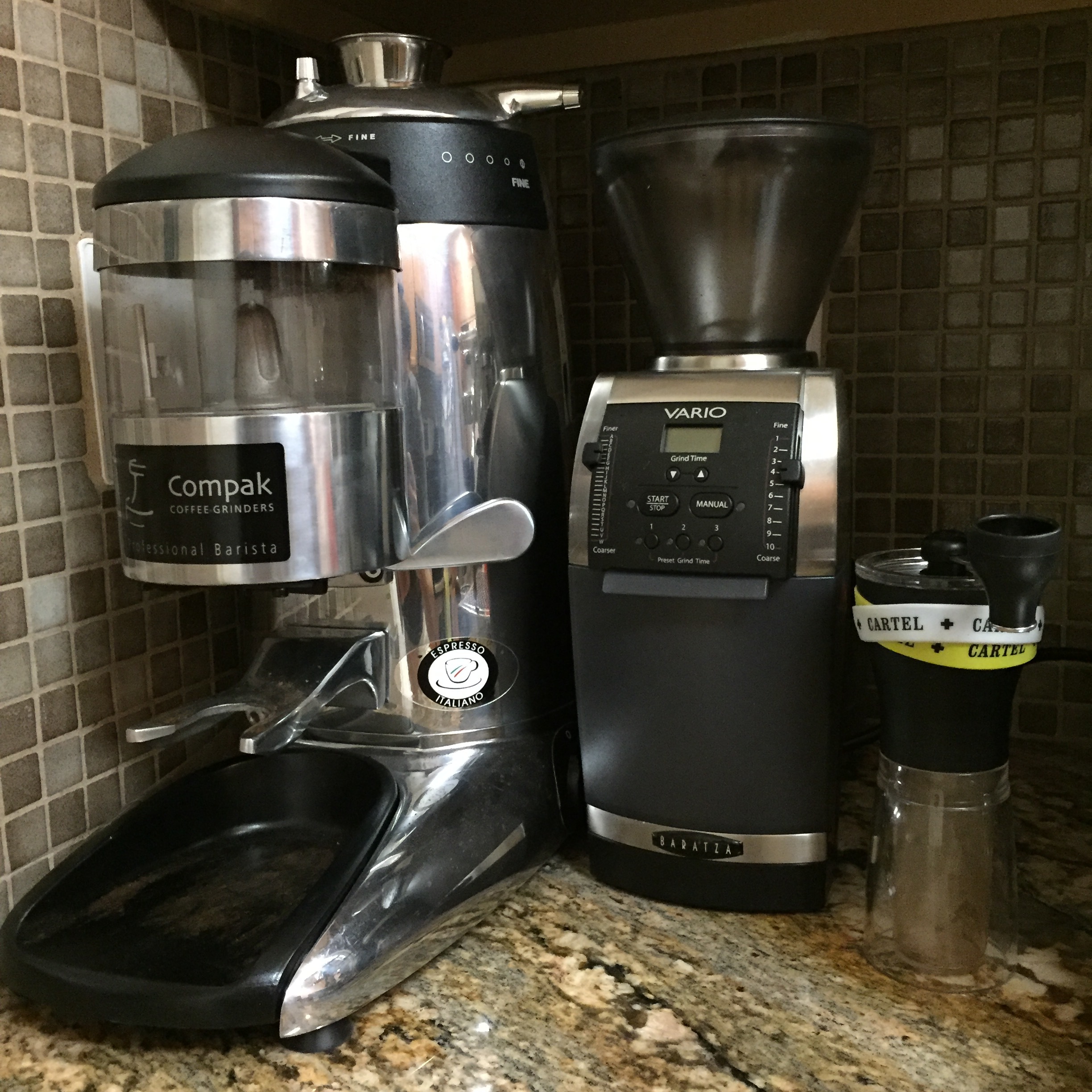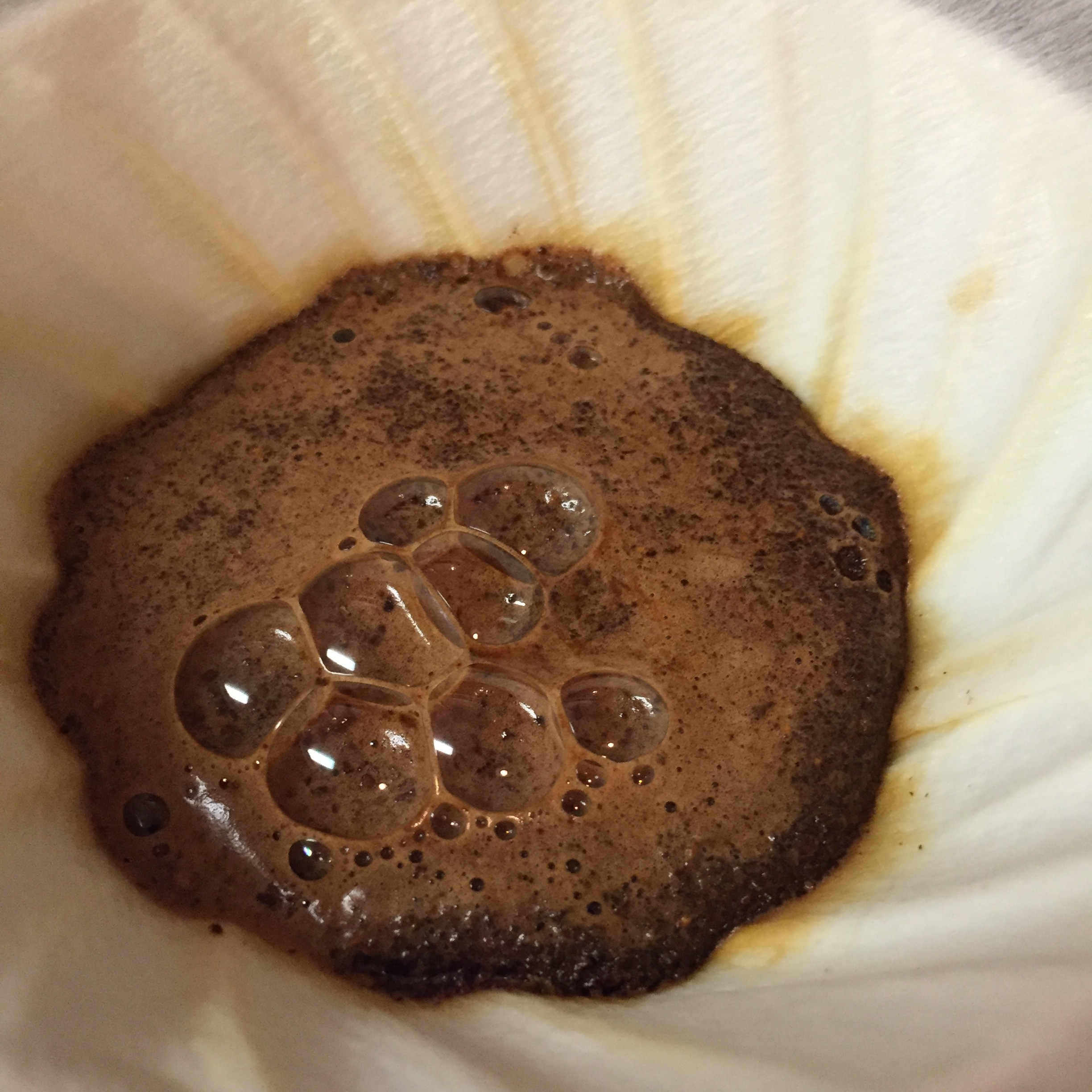Buying Coffee Equipment: Manual & Pourover Brewing Equipment at Home
Manual coffee brewing is a great, relatively easy (though it can be made very complicated), and relatively inexpensive way to make great coffee at home. I covered nearly all of the common manual brewers in this post: Buying Coffee Equipment: Under $100 – Brewing Devices, but today I’m going to round out the essential for a manual brewing setup.
Grinder
The espresso capable Baratza Vario is an excellent brew grinder & the Hario Mini Mill is my travel companion.
As always, it’s grinder first; I went pretty in-depth with grinder options up to $1000 in this post: Buying Coffee Equipment Part 3: Grinders, and the grinder is and always will remain the most important piece of the brewing equation. If you’re only seeking a grinder to handle manual and even automatic drip brewing duties, electric grinders like the Baratza Encore and Breville Smart Pro and Dose Control Pro are great low cost options, with grinders like the new Baratza Sette 270 and Baratza Vario offering even more control and adjustment and higher quality and consistency of grinds. On the hand crank side, an Orphan Espresso Lido 3 makes for a user friendly hand grinder that is easy enough for everyday in home use, but can also pack up nicely for travelling. (I’m trying to put off buying one, since my current hand grinder does “work”.) It’s truly worth it to buy the best grinder you can afford, and with manual brewing devices being relatively inexpensive, this advice seems that much more pertinent. Bonus points go to the Sette 270 and Vario because they are capable of handling espresso duties if your coffee adventures take you down that road.
Brewing Device
Brewing devices are largely personal preference depending on taste, and some suit different coffees better than others. In general, pour over brewers, where the water passes directly through the ground coffee, will result in lighter, cleaner, and more nuanced cups, while immersion style brewers, the keep the grounds immersed in water until the water is released or pushed through, will have more body, depth, and sweetness. The Kalita Wave seems to be the hot pourover brewing device as of recent due to its forgiving and even extracting flat bottom design. I personally use an 02 size Hario V60 ceramic as my thinking was 02 size V-shape filters are easier to find, even in the grocery store, than the smaller flat bottom Kalita style. In reality, I strongly prefer the Hario specific paper filter, because they are very thin, so I typically end up ordering them anyways. Because there are so many manual brewing methods, and since most think of a traditional V60 style pourover when talking about manual brewing, the remainder is writing with V60 brewing in mind.
Scale
You'll also want a scale accurate to .1 grams. For brewing in particular, having a scale with a higher weight limit, 1000 grams or more, and large platform is helpful so you can accommodate the brewer and brewing vessel. A few common scale options are covered in the accessories page here: Buying Coffee Equipment: The Accessories.
Kettle
The Bonavita Digital Variable Temperature Gooseneck Kettle is my favorite!
The kettle is the only other piece of equipment that I haven’t covered in the past, but reference often in #whatsCTpulling. Kettles come in a wide variety of shapes, sizes, designs, and metals, but in the end it’s important to get one you feel you can control, and that is a gooseneck style. You’ll need the gooseneck style kettle to be able to control both the flow and aim of the water during brewing. In general, kettles are either stovetop or electric style, with my personal favorite being the temperature controlled electric kettle from Bonavita. With a stovetop or non-temperature controlled electric kettle you will need/want a thermometer to monitor water temperature, which is why I really like the temperature controlled option. I also really like the Bonavita option because I can fill up the kettle, turn it on, set it to a temp, and then continue on with my morning routine while it’s warming up. As you can probably tell I’m quite fond of the Bonavita option, and partially because it isn’t much more expensive than a standard gooseneck kettle and provides the convenience of preset temperature options for different coffees and/or teas, as well was a timer, hold temperature function, and auto on/off. I happened to score mine for less than what the stovetop models usually cost from massdrop, which is a group buy site where deals come up from manufacturers at prices well below retail. I’ve also seen them come up for cheap from time to time on Amazon.
Brewing
Now that you have all your gear, and assuming you're using high quality, fresh coffee like what is outlined here: Buying Coffee Equipment Part 2: The Coffee, add some good quality filtered water to your kettle and let's look at how to brew a cup. One of the neat things about brewing, and coffee in general, is there are guidelines and tips but ultimately what is best, is what tastes best, to you. With that said, I'm going to leave it to the professionals on this one and link some of my favorite brewing guides. I often find myself using a combination of many depending on the coffee and what it needs.
First up is teen heart throb and barista extraordinaire Matt Perger's V60 brewing video. I like how Matt goes about things in a well thought out, challenging, and sensible manner. His thoughts are always provoking, and his blog and weekly news letter are definitely worth a read. I would say this method is the one I use most often and I like the full extractions I'm able to achieve.
Although I play around with various aspects of all of these techniques and more, another that I find I rely on very heavily due to its simplicity, repeat-ability, and good results is Scott Rao's method. Lately, I would describe my approach as being following the principles of Rao's technique with some aspects of Matt Perger's and others thrown in.
Intelligentsia Coffee comes through with simple and easy to follow written instructions to tape to the inside of the kitchen cabinet door.
In a method similar to Mr. Perger's, Heart Coffee Roasters also utilizes a lot of stirring and pays extra attention to not leaving any stray grounds on the sides of the filter.
And last, but certainly not least, in what might be the hipster-iest video of all time, Stumptown Coffee Roasters raps out the process using less stirring but a more continuous pour method. You'll notice that they use an electric kettle to bring the water to boil, and then transfer into a specialty kettle with a very restricted flow that allows them to do this.
And that's it. There are tons of brewing methods and recipes out there. Be sure to experiment and see what works best for you. Do you have an unusual method you like? Please reach out and share it via Twitter or the contact page! And as always, you can follow along with the weekly #whatsCTpulling blog to see what brewing parameters are working best for me that week.




